Knowing a wide variety of sight words is SO KEY for primary students when they are learning to read.
When your students are able to instantly identify key words without needing to pause and reflect, their brains then have more energy to decode the new words in their text that they haven’t seen before.
They are also better able to make sense of what they are reading when they don’t have to decode every word, so they are better able to predict the new words that are coming up.
Knowing their sight words also helps your students big time with their fluency, as well as their confidence. Sight words make up a huge percentage of the words in just about any text (and certainly any text that your students will be reading in kinder).
Once your students realize that they can string together whole sentences with the sight words that they know, they will feel like readers right away!
Also, certain words simply cannot be decoded in the French language – think est, et, les, etc.
You can’t just slide your finger under those letters, say each sound out loud, and come up with the right word!
It is essential that our students memorize these high-frequency words to help them start reading as soon as possible, and feel like capable, successful readers.
However, as important as they are, sight words can be quite the monster in kindergarten! Our students are alllll over the map – some learn sight words more quickly than you can teach them, while others take much longer to learn even the “easiest” sight words. Some students also find it easy to read sight words within the context of a sentence, but struggle in isolation – or vice versa. With such a wide range of abilities, how can you possibly teach everyone at their pace and make sure they are staying engaged? It can also be tricky to motivate students to memorize their sight words – how can you encourage them to practice their words over and over until they stick?
I struggled big-time with teaching sight words during my first two years of teaching. I couldn’t teach new words fast enough for some of my students, yet was moving waaaay too quickly for others. I knew that I had to differentiate my sight word instruction in order to reach all of my students, but I didn’t have an organized system in place (or even an end goal for my students, aside from a vague “learn as many sight words as possible!”), and I was causing myself so much work. And sight words are just one tiny part of the curriculum… I was totally overwhelmed trying to teach those along with letters, sounds, blending, segmenting, syllables, etc. etc!
Confession: I am totally a Type B teacher and do many things well on the fly, while being flexible to my students’ “in the moment” needs. However, I was really struggling to reach all of my students in this way with my sight word instruction (understandably so!). I don’t like feeling unsuccessful, so I finally sat down one weekend and decided to figure out a system that WORKED for me. Today I will share with you how I did that! As with all of my blog posts, please don’t think that my way is the only way – my goal is to share lots of ideas with you, so that you can take them and tweak them to suit your needs. If you are feeling overwhelmed about sight words and your students’ varying needs, here is what I suggest!
1. THINK BIG PICTURE TO START
A big problem for me was that I wasn’t thinking big picture. I didn’t have an end goal in mind at all… aside from getting my students to learn #AllOfTheSightWords. When you sit down to put together your sight word program, ask yourself this… in a perfect world, how many sight words would you like your students to learn? Are they all going to learn them all? Nope! But some will. Maybe more than you think!
You may already have a list provided to you by your school or board – if so, use that! My board doesn’t have a list for maternelle that I can find, so I adapted the grade one list a bit and came up with a list of 90 words.
Once you have your master list, divide it up into smaller chunks. The goal is for your students to learn all of the words, but in my experience, it is much easier and more motivating for them to learn them a few at a time. I divided my master list up into nine groups with 10 words each. I gave each list a colour (and an ocean creature), and made sure to put what I consider the “easiest” words on the first list. Here are the lists I came up with:
I recommend not putting words that look super similar together on the first list. We really want our students to experience success ASAP! That is why I put le on the first list, but waited to put la on the second list – the shapes of those words are almost the exact same, and if your students don’t know their sounds yet, they probably won’t be able to tell them apart.
You don’t have to use colours or an ocean theme for your lists – you could use animals, numbers, or anything you like!
2. MAKE FLASH CARDS
I’m sure you can figure out that I’m going to suggest that you make flash cards for each word on your lists. However, I highly recommend also making flash cards with fluency phrases for each list! Just string together the words from your lists into simple sentences. Maman regarde papa. « Regarde papa! » dit maman., etc. Some children learn words more easily in isolation, while others learn better with the words in context.
t is also suuuuper important to start developing our young readers’ fluency from the very beginning, and these fluency phrases can really help with that. Your students will be able to read their fluency phrases before reading actual books; it doesn’t get much closer to the beginning than right here!
I print my flash cards out on the same coloured paper as the list name. Red words and sentences on red paper, orange on orange, etc. I get my card stock from Michael’s whenever it’s on sale! I hole punch the corners and hold the cards together on a binder ring.
I also recommend having your fluency phrases build with each list. So, my red fluency phrases contain only red words*, but the orange phrases contain red AND orange words. Yellow contains yellow, red, and orange words – and so on. The turquoise sentences can include words from any list. This keeps your students practicing all of their words, even once they have mastered a list!
* if there is any word included that is not on that list, I add a picture. For example, a red sentence may read “Maman a le chat,” but I would include a picture of a cat on the card.
3. REVIEW AND SEND HOME
You make not be allowed to send homework home, in which case, you can skip this part and just give your students time to practice their words at school. I put my students’ flash cards right in their reading bags, as part of their reading homework (in fact, that is all that I send home for homework – books and flash cards!).
I don’t start sending home the red list until I have taught and reviewed all 10 words, whole-group style. Will they all know them? Definitely not! The extra practice at home is very important. Some will master the red list very quickly, and some will take longer – this is okay! We have lots of talks about how it isn’t a race, and if we want to do better, then we should practice more. I am very careful to always attribute a students’ success to their work ethic, and never say things like “wow, you are so smart/so good at sight words/etc”! Students need to know from the very beginning that hard work is the key to success – not just being “smart”. They will all end up struggling somewhere down the line!
I find that these sight words give my students a concrete example that practice makes perfect, and I love that about them. The most determined of my students figure out strategies and studying tips via these lists that I believe will serve them for the rest of their lives. For example, at parent-teacher, a parent shared with me a story of how her daughter just could not for the life of her remember “il y a”. So, she put her cards on the floor and did cartwheel after cartwheel over “il y a”, saying it again and again until it stuck! This student is now on the purple list – she has learned over 50 sight words so far this year and it isn’t even Christmas yet!!
Another parent shared a story about her twins – one twin is much farther ahead than the other in her lists. She sits at the table, in the car, on the bus, etc. and does her lists over and over and over again until she gets them! The other twin isn’t as concerned with advancing as quickly with his lists, but he still gets to see a concrete example of how much farther ahead practicing could get him – and hopefully her work ethic will rub off on him eventually ;)
4. EVALUATE AND PRACTICE THE NEXT LIST
When do I evaluate my students’ lists? Whenever I can!!! You would be amazed at where you can squeeze in a few minutes. I can usually get through a couple of students first thing in the morning before the bell, or while they are working independently. Sometimes I evaluate during small group time, and sometimes I will grab a student if they finish their snack or their work early. They are excited for me to hear them read their lists and will often let me know when they think they are ready.
I only send home a new list when a student can read me all 10 words on their list and read their fluency phrases without any sight word mistakes. It is important to me that their knowledge is solid, as they will continue to see these words in their future lists.
As I said above, I believe that homework should be review rather than new learning. So, I always go over each list a couple of times with each student before I send them home. Again, I just find time wherever I can squeeze it in!
I use evaluation sheets like the one pictured below to evaluate my students. I usually don’t bother with them for the phrases and just use them for the words. I like making note of any mix-ups they make, as I can use that knowledge during my small group instruction time.
I keep all the sheets in my data binder. Each student has their own section.
5. PRAISE, ENCOURAGE, AND REWARD
When my students finish a list, we make a big deal out of it! Each student gets a certificate for every list they finish, and the whole class sings to them and claps for them. I print their certificate on paper of the same colour, and we sing:
“J’ai des grandes nouvelles!
On a quelqu’un à féliciter!
(nom de l’élève) peut lire la liste (couleur) –
Sans difficulté!”
Each of my students has a folder, with a progress sheet glued to the front. Each time they master a list, they colour the corresponding ocean creature in the correct colour (with a Mr. Sketch marker!!! #bigdeal). They put their certificate in their folder, take it home to show their parents, and then bring it back to me.
I also have a ZERO-TOLERANCE policy for anyone putting someone else down about their lists. I make this very clear from day one. If I get wind of a student making someone feel small about what list they are on, then they no longer participate with the coloured flash cards. I simply would send home the list of all 90 words and they can learn them like that (this hasn’t happened yet, but it was close to happening this year).
Our brains are all different and there is no need to compare one student to another – we should only be comparing one student to where they were in the beginning and how far they end up by the end! :)
BONUS TIP: GIVE YOUR STUDENTS OTHER OPPORTUNITIES TO PRACTICE
We all know that practice makes perfect, so any opportunity you can give your students to practice their words, the better! You can make sight-word games using words from their lists to use during small group time. You can make centres that students use their word lists to complete (building words with beads, letter tiles, writing them on white boards, etc.) – the sky is the limit!
Reading buddies or Amis de lecture is another fantastic time for your students to practice their lists!!
I talked in last week’s post about a little speed reading challenge I like to use as part of our Lecture à soi centre. I call it Lecture de vitesse, and it is perfect for a little extra sight word practice. I created it to correspond exactly with my coloured sight word lists. The winter set looks like this:
Basically, you print out the cards for each list, and attach each list together with a binder ring. If your lists are the same as mine, you can add the “Liste …” cover page so your students know which list to grab. If not, you can just make your own groups of words (the cards are editable!), and use the numbered cover pages (as picture on the “I Can” card above). There are also cards with fluency phrases for each list included, so they can practice those, too!
(To save on time and ink, I often alternate what I print and prep – for the winter theme I might do just the sight word lists, then for the spring theme I would do just the phrases, etc.)
Students grab a stopwatch, a recording sheet, and the list that they are working on, and read the cards as fast as they can, while timing themselves. They record their time and do it again, trying to beat their time and get faster and faster.
I have a bundle of Lecture de vitesse sets in my store – I like changing the themes throughout the year so that it stays exciting and fresh. Each set contains the same words and phrases, but with different clip art to fit the time of year. My students love this activity, and I love the extra practice they get!
I hope that this post made it a little clearer how I teach and practice sight words, and how I have managed to differentiate for my students. I of course continue to teach and practice sight words whole-group via various activities (the bottom of this post has an example of one game that we love!), but because I have this system in place, I feel that I am better able to reach ALL of my students, and I am not holding back those who are ready for more.
If my list of 90 words seems perfect for you, and you don’t want to go through the hassle of typing up your own lists and flash cards and coming up with your own fluency phrases, I do sell my lists ready-made in a resource in my TPT store. It is called Apprendre les mots fréquents and is available here. It comes with all of the flash cards for each list, as well as sheets for recording student progress, evaluation sheets, certificates, and a sight word game that you can use as a centre or when working with a small group. It just recently had a huge update, with new clip art, fonts, etc. (that means if you already own it, you can go redownload it and get your updated version free!). Over 100 pages of sight word goodness! To celebrate the update (it was a long time coming!!), it is on sale for 20% off until Thursday!
As always, if you have any questions about anything in this post, don’t hesitate to reach out in the comments below!


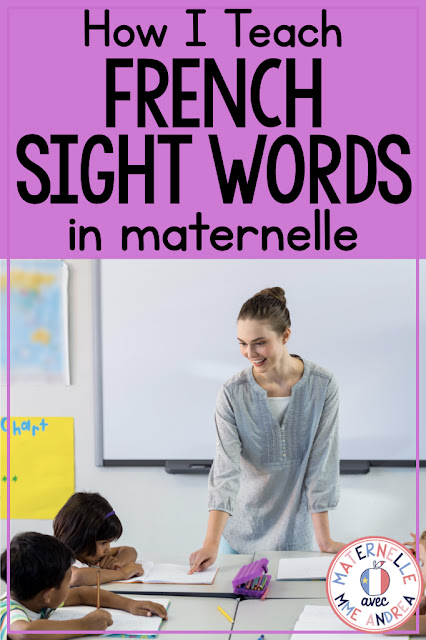
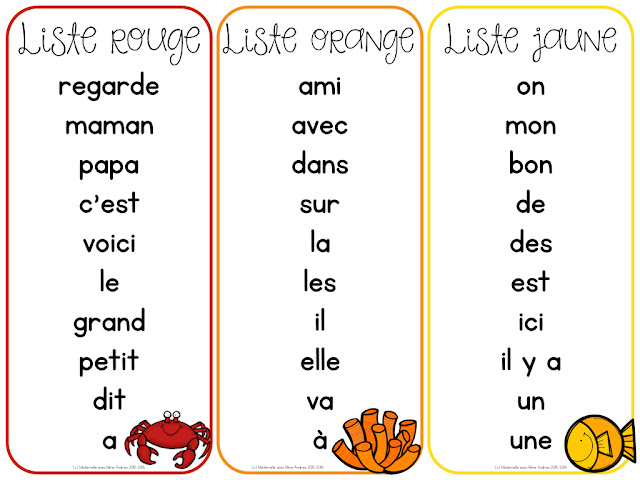

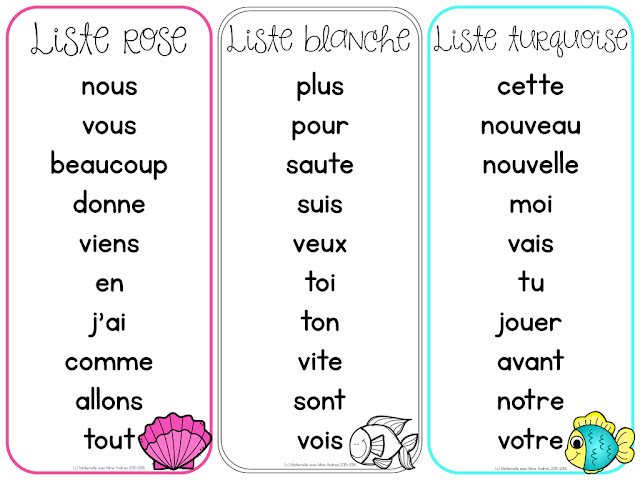
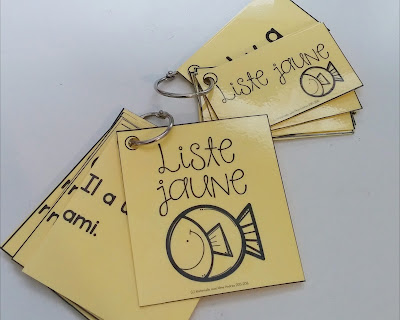
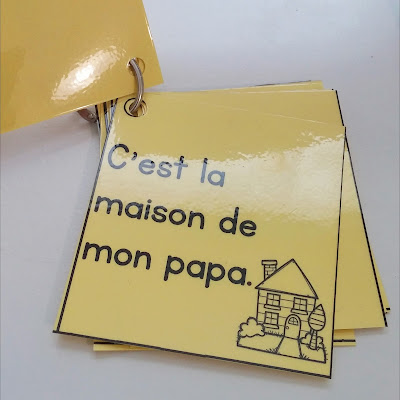
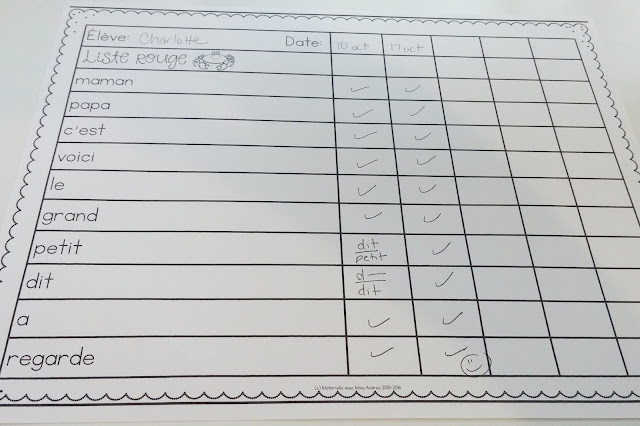
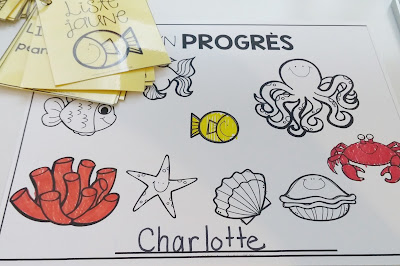

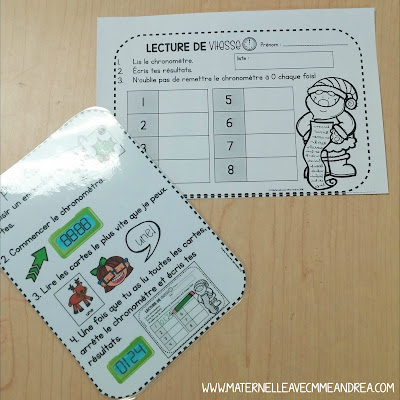
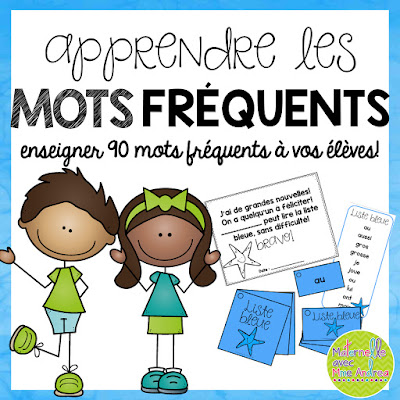



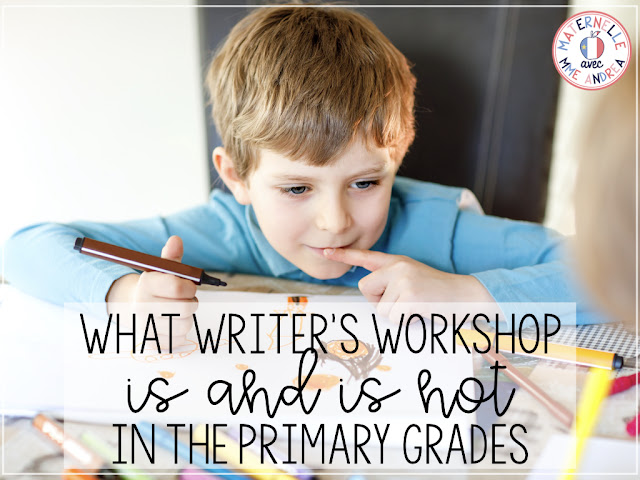
I'm wondering how you teach the subsequent lists, as students are ready to move on to the next list at different times. Do you still teach them in the whole group, even if there are students that are several lists behind the list being taught, or do you find it works better in small group settings after the initial liste rouge?
Hi! Great question. After the red list, I find it easiest to teach and review the other lists in a small group setting, grouping students who are on the same list. However, I still teach some words whole-group, and ignore what official list they are on and instead go by the needs of the group. For example, the winter sentences we are working on whole-group have the word « peux », which we hadn't seen together before, so I taught and we practiced that word whole-group this week, even though not all students are on that list. I also teach the word « j'aime » super early in the year, but it isn't seen until the green list. I try to think about the sight word needs of my class as a whole group, as well as the needs of my small groups, and do what I can for both. I find it helps my students' confidence when they already know a word or two on their new lists anyway! It has been working well for us! :)